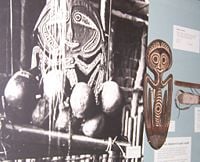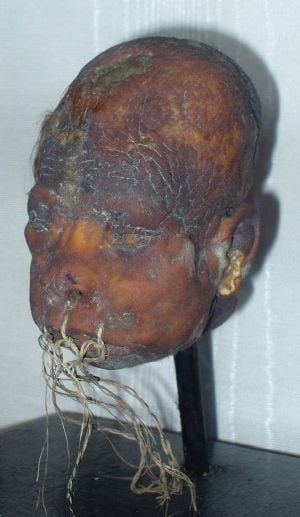Headhunting
A headhunter was a person who killed another and then took the other's head. Headhunting was practiced in the precolonial era in parts of Nigeria, Nurestan, Assam, Myanmar, Borneo, Indonesia, the Philippines, Taiwan, Micronesia, Melanesia, New Zealand, the Amazon Basin, and among certain sects of the Celts of ancient Europe. Today it is a universally prohibited practice, and appears to have died out as of the mid-20th century.
As a practice, headhunting has been the subject of intense discussion within the anthropological community as to its possible social roles, functions and motivations. Contemporary scholars generally agree that its primary function was ceremonial, and that it was part of the process of structuring, reinforcing and defending hierarchical relationships between communities and individuals. The debate is about the finer detail. Some believe that it was practiced because of a belief that the head contained "soul matter" or life force that could be harnessed through its capture. Themes that arise in anthropological writings about headhunting include mortification of the rival, ritual violence, cosmological balance, the display of manhood, cannibalism and prestige.
Shrunken Head
- Shrunken heads redirects here. For the film, see Shrunken Heads.
An authentic shrunken head is a human head that has been prepared for display.
The manufacture of shrunken heads was formerly the specialty of a number of ethnic groups that practiced headhunting, most notably the Jívaro or Shuar people of present day Ecuador and Peru. Among the Shuar, a shrunken head is known as a tsantsa.
In World War II shrunken heads of prisoners were also found in German concentration camps. Most notable findings were in the Buchenwald camp, where they were displayed in the camp centre to terrify the prisoners.
How it was done
The shrinking process primarily involved the desiccation of the skin. The skull was removed from the head: the maker would make an incision on the back of the neck and proceeded to remove all the skin and flesh from the cranium. Afterwards, they sewed the eyelids shut and held the mouth together with splinters. Fat from the flesh of the head was removed. The flesh was then boiled in water in which a number of herbs containing tannins were steeped, then dried with hot rocks and sand, while being molded by the preparer to retain its human feature. The lips were sewn shut, and various decorative beads were added to the head.
Shrunken heads are known for their mandibular prognathism, facial distortion and shrinkage of the lateral sides of the forehead; these are artifices of the shrinking process.
The process to reduce the size of the heads was accompanied by a ritual, which culminated with la Fiesta de la Victoria (Spanish for "victory feast") celebrated by the entire community.
Why it was done
The practice of making shrunken heads originally had religious significance; the heads were believed to harness the spirits of those enemies and compel them to serve the shrinker.
They believed in the existence of three fundamental spirits:
- Wakani - innate to humans thus surviving their death, later turning into vapor.
- Arutam - literally "vision" or "power," protects humans from a violent death and assures their survival.
- Muisak - vengeful spirit, which surfaces when an arutam spirit-carrying person is murdered.
To block the last spirit from using its powers, they decided to sever their enemy's heads and shrink them. It also served as a way of warning those enemies.
Trade in shrunken heads
At first, cultural restrictions meant that deaths from traditional conflict were relatively rare[citation needed], and few shrunken heads were made. When outsiders created an economic demand for shrunken heads, however, there was a sharp increase in the rate of killings in an effort to supply collectors and tourists[dubious — see talk page][citation needed]. A stop was put to this when the Peruvian and Ecuadorian governments outlawed the traffic in heads.
Currently, replica shrunken heads are manufactured as curios for the tourist trade. These are made from leather and animal hides carved to resemble the originals. Replica shrunken heads, due to their provocative nature, are also popular in the hotrod culture, where they are often seen hanging from rearview mirrors as ornaments.
The presence or absence of nasal hair is one clue as to whether a shrunken head is authentic or a replica. The largest collection of authentic shrunken heads is on display at Ye olde curiosity shoppe in Seattle, WA, USA with 7 heads. It also houses the smallest shrunken head in the world which is about the size of a tennis ball.
Southeast Asia and Melanesia

Headhunting was practiced in many parts of Southeast Asia. Anthropological writings exist on the Ilongot, Iban, Dayak, Berawan, Wana, Mappurondo, and others. Among these groups, headhunting was usually a ritual activity rather than an act of war or feuding, and involved the taking of a single head. Headhunting acted as a catalyst for the cessation of personal and collective mourning for the community's dead. Ideas of manhood were wrapped up in the practice and the taken heads were prized.
Kenneth George (1996) wrote about annual headhunting rituals that he observed among the mappurondo religious minority, an upland tribe in the south-west part of the Indonesian island of Sulawesi. Actual heads are not taken; instead, surrogate heads are used, in the form of coconuts. The ritual, called pangngae, takes place at the conclusion of the rice harvesting season. It functions to bring an end to communal mourning for the deceased of the past year, express intercultural tensions and polemics, allow men to display manhood, distribute communal resources, and resist outside pressures to abandon mappurondo lifeways.
Around the 1930s, headhunting was suppressed among the Taiwanese aborigines during the Japanese occupation of Taiwan and among the Ilongot in the Philippines by the US authorities. In Sarawak on the island of Borneo, the colonial dynasty of James Brooke and his descendants eradicated headhunting in the hundred years before World War II.
Some believe that Michael Rockefeller may have been taken by headhunters in western New Guinea as recently as 1961.
Amazon
The Shuar in Amazonian Ecuador and Peru practiced headhunting in order to make shrunken heads and use them for ritual purposes. The practice is no longer current, but the Shuar still produce replica heads which they sell to tourists.
New Zealand
In what is now known as New Zealand, the Māori would preserve the heads of enemies, removing the skull and smoking the head. Māori are currently attempting to reclaim the heads of their ancestors held in museums outside New Zealand.
China
During the Spring and Autumn Period and Warring States Period, Qin soldiers were prone to collect their enemies' heads. Since most of the soldiers were slaves, they and their families could be freed from slavery and even secure promotions in the army by returning victorious with heads. The act of Qin soldiers carrying heads in battles usually terrified their foes. This is why headhunting is one of the factors in the Qin dynasty defeating six other nations and unifying China.
After the Qin dynasty, headhunting ceased to be practiced amongst Chinese people.
Celts
The Celts of Europe practiced headhunting for an indeterminate religious reason. Romans and Greeks recorded their habits of nailing heads of personal enemies to walls, or dangling them from the necks of horses, and human skulls are found amongst votive offerings. Headhunting was still, in a form, practiced for a great deal longer by the demi-Celtic Gaels, though this was probably more traditional than religious, as the religious reasons for collecting the heads was likely lost after their conversion to Christianity. Heads were also taken among the Germanic tribes and Iberians, but the purpose is unknown.
ReferencesISBN links support NWE through referral fees
- Kenneth George (1996). Showing signs of violence: The cultural politics of a twentieth-century headhunting ritual. Berkeley: University of California Press. ISBN 0-52020-041-1
External links
- Head Hunting: History of the Shuar
- Shrunken heads from the Discovery Channel[1]
- General information
- Description of the head shrinking process (in Spanish)
- [http://shamash.org/holocaust/photos/images/Shrunken.jpg Picture of a shrunken head from the Buchenwald concentration camp
- Encyclopedia Britannica entry 1996
- Headhunting and headshrinking among the Shuar
Credits
New World Encyclopedia writers and editors rewrote and completed the Wikipedia article in accordance with New World Encyclopedia standards. This article abides by terms of the Creative Commons CC-by-sa 3.0 License (CC-by-sa), which may be used and disseminated with proper attribution. Credit is due under the terms of this license that can reference both the New World Encyclopedia contributors and the selfless volunteer contributors of the Wikimedia Foundation. To cite this article click here for a list of acceptable citing formats.The history of earlier contributions by wikipedians is accessible to researchers here:
The history of this article since it was imported to New World Encyclopedia:
Note: Some restrictions may apply to use of individual images which are separately licensed.

